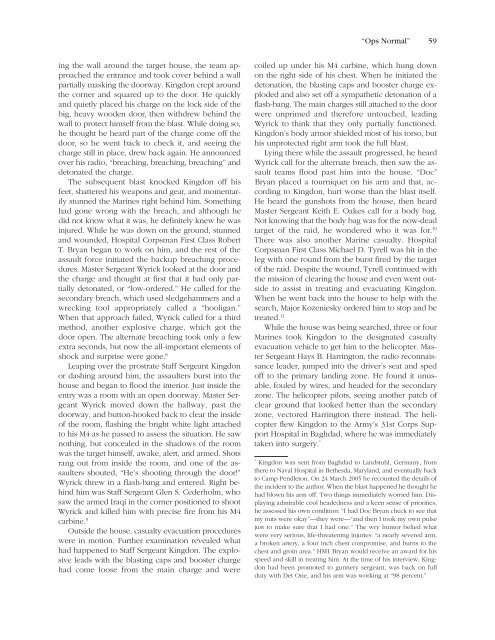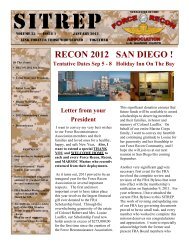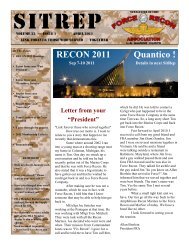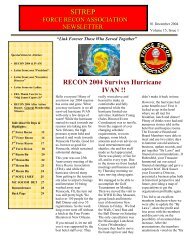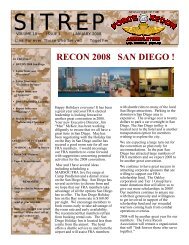Det One - Force Recon Association
Det One - Force Recon Association
Det One - Force Recon Association
Create successful ePaper yourself
Turn your PDF publications into a flip-book with our unique Google optimized e-Paper software.
“Ops Normal” 59<br />
ing the wall around the target house, the team approached<br />
the entrance and took cover behind a wall<br />
partially masking the doorway. Kingdon crept around<br />
the corner and squared up to the door. He quickly<br />
and quietly placed his charge on the lock side of the<br />
big, heavy wooden door, then withdrew behind the<br />
wall to protect himself from the blast. While doing so,<br />
he thought he heard part of the charge come off the<br />
door, so he went back to check it, and seeing the<br />
charge still in place, drew back again. He announced<br />
over his radio, “breaching, breaching, breaching” and<br />
detonated the charge.<br />
The subsequent blast knocked Kingdon off his<br />
feet, shattered his weapons and gear, and momentarily<br />
stunned the Marines right behind him. Something<br />
had gone wrong with the breach, and although he<br />
did not know what it was, he definitely knew he was<br />
injured. While he was down on the ground, stunned<br />
and wounded, Hospital Corpsman First Class Robert<br />
T. Bryan began to work on him, and the rest of the<br />
assault force initiated the backup breaching procedures.<br />
Master Sergeant Wyrick looked at the door and<br />
the charge and thought at first that it had only partially<br />
detonated, or “low-ordered.” He called for the<br />
secondary breach, which used sledgehammers and a<br />
wrecking tool appropriately called a “hooligan.”<br />
When that approach failed, Wyrick called for a third<br />
method, another explosive charge, which got the<br />
door open. The alternate breaching took only a few<br />
extra seconds, but now the all-important elements of<br />
shock and surprise were gone. 8<br />
Leaping over the prostrate Staff Sergeant Kingdon<br />
or dashing around him, the assaulters burst into the<br />
house and began to flood the interior. Just inside the<br />
entry was a room with an open doorway. Master Sergeant<br />
Wyrick moved down the hallway, past the<br />
doorway, and button-hooked back to clear the inside<br />
of the room, flashing the bright white light attached<br />
to his M4 as he passed to assess the situation. He saw<br />
nothing, but concealed in the shadows of the room<br />
was the target himself, awake, alert, and armed. Shots<br />
rang out from inside the room, and one of the assaulters<br />
shouted, “He’s shooting through the door!”<br />
Wyrick threw in a flash-bang and entered. Right behind<br />
him was Staff Sergeant Glen S. Cederholm, who<br />
saw the armed Iraqi in the corner positioned to shoot<br />
Wyrick and killed him with precise fire from his M4<br />
carbine. 9<br />
Outside the house, casualty evacuation procedures<br />
were in motion. Further examination revealed what<br />
had happened to Staff Sergeant Kingdon. The explosive<br />
leads with the blasting caps and booster charge<br />
had come loose from the main charge and were<br />
coiled up under his M4 carbine, which hung down<br />
on the right side of his chest. When he initiated the<br />
detonation, the blasting caps and booster charge exploded<br />
and also set off a sympathetic detonation of a<br />
flash-bang. The main charges still attached to the door<br />
were unprimed and therefore untouched, leading<br />
Wyrick to think that they only partially functioned.<br />
Kingdon’s body armor shielded most of his torso, but<br />
his unprotected right arm took the full blast.<br />
Lying there while the assault progressed, he heard<br />
Wyrick call for the alternate breach, then saw the assault<br />
teams flood past him into the house. “Doc”<br />
Bryan placed a tourniquet on his arm and that, according<br />
to Kingdon, hurt worse than the blast itself.<br />
He heard the gunshots from the house, then heard<br />
Master Sergeant Keith E. Oakes call for a body bag.<br />
Not knowing that the body bag was for the now-dead<br />
target of the raid, he wondered who it was for. 10<br />
There was also another Marine casualty. Hospital<br />
Corpsman First Class Michael D. Tyrell was hit in the<br />
leg with one round from the burst fired by the target<br />
of the raid. Despite the wound, Tyrell continued with<br />
the mission of clearing the house and even went outside<br />
to assist in treating and evacuating Kingdon.<br />
When he went back into the house to help with the<br />
search, Major Kozeniesky ordered him to stop and be<br />
treated. 11<br />
While the house was being searched, three or four<br />
Marines took Kingdon to the designated casualty<br />
evacuation vehicle to get him to the helicopter. Master<br />
Sergeant Hays B. Harrington, the radio reconnaissance<br />
leader, jumped into the driver’s seat and sped<br />
off to the primary landing zone. He found it unusable,<br />
fouled by wires, and headed for the secondary<br />
zone. The helicopter pilots, seeing another patch of<br />
clear ground that looked better than the secondary<br />
zone, vectored Harrington there instead. The helicopter<br />
flew Kingdon to the Army’s 31st Corps Support<br />
Hospital in Baghdad, where he was immediately<br />
taken into surgery. *<br />
*<br />
Kingdon was sent from Baghdad to Landstuhl, Germany, from<br />
there to Naval Hospital in Bethesda, Maryland, and eventually back<br />
to Camp Pendleton. On 24 March 2005 he recounted the details of<br />
the incident to the author. When the blast happened he thought he<br />
had blown his arm off. Two things immediately worried him. Displaying<br />
admirable cool headedness and a keen sense of priorities,<br />
he assessed his own condition: “I had Doc Bryan check to see that<br />
my nuts were okay”—they were—“and then I took my own pulse<br />
just to make sure that I had one.” The wry humor belied what<br />
were very serious, life-threatening injuries: “a nearly severed arm,<br />
a broken artery, a four inch chest compromise, and burns to the<br />
chest and groin area.” HM1 Bryan would receive an award for his<br />
speed and skill in treating him. At the time of his interview, Kingdon<br />
had been promoted to gunnery sergeant, was back on full<br />
duty with <strong>Det</strong> <strong>One</strong>, and his arm was working at “98 percent.”


